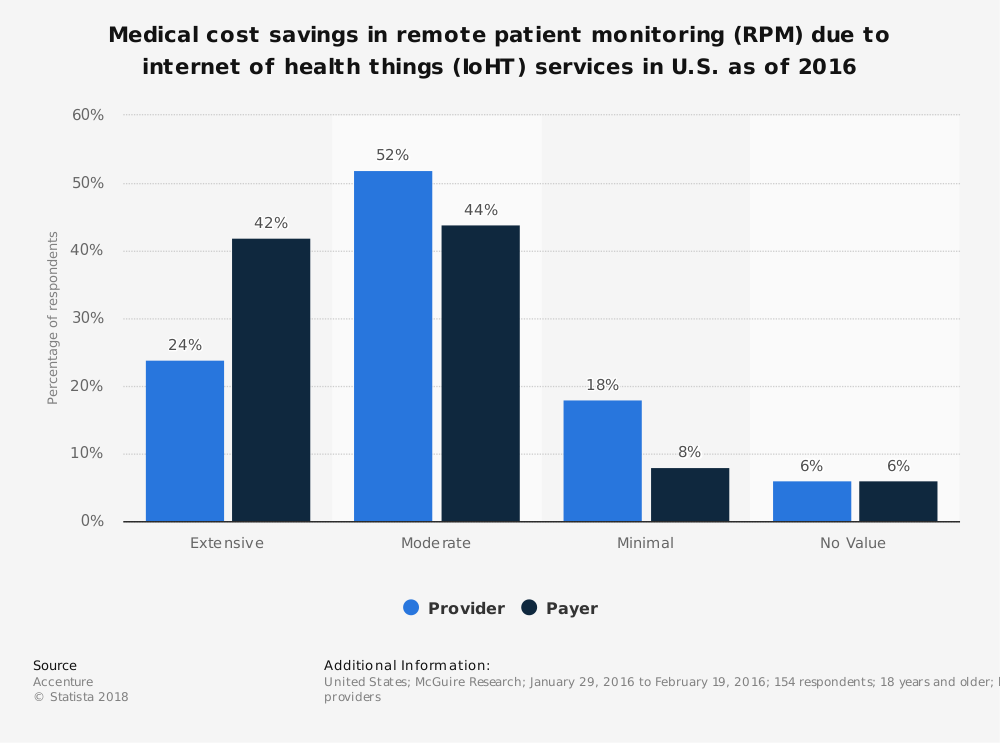
Value-based care remains the focal point in the Home Health Care industry. The nationwide rollout
RPM is the use of digital technology to monitor and capture medical and other health records from patients electronically and further transmit them to healthcare providers for assessment. The process is implemented with prior recommendation and instruction from the physician. RPM helps continuous tracking of healthcare data for patients and encourages them to take control of their health regularly.
RPM can be used to collect patients’ health data, including blood pressure, vital signs, weight, heart rate, blood sugar levels, and physical activity. The most commonly used RPM devices are blood pressure monitors, weight scales, cardiac implants, blood glucose meters, and pulse oximeters. Specialties frequently embracing RPM include cardiology, pulmonology, endocrinology, gastroenterology, and bariatrics. Hypertension, obesity, congestive heart failure (CHF), chronic lower respiratory disease (COPD), and diabetes are the most common disease managed by RPM.
Chronic patients are the biggest prospective clients for RPM, as they are synonymous with continuous asymptomatic issues. Adoption of the RPM model is now a must, as it focuses more on clinical efficiency than just clinical care.
Physicians and qualified healthcare professionals can provide for RPM. It is soon becoming an integral part of the Home Health Agencies. The agency should ideally offer the RPM device to the patients and train them on its usage. Many a time, a patient might require more than one device. The agency has to make sure the patient has a WIFI connection, a Smartphone, and a Personal computer at their home to enable RPM services. Patients may also need in-person or virtual assistance to set up and use the devices for RPM.
RPM should ideally be suggested or prescribed for patients with the medical necessity to check medical records regularly or daily. These should reflect in their medical records. Generally, RPM is proposed for patients recently discharged from the hospital and patients who are critically ill or have a long-term ailment. People are empowered and engaged to manage their health when discussing self-generated health data through RPM.
69% of healthcare professionals have ranked RPM the #1 reducer of overall costs. Over the next 25 years, $200 billion in healthcare costs will be saved globally due to the implementation of RPM. It is a driver for Value-Based Care, as it improves care for patients and cuts costs for providers by reducing hospital readmissions and ER visits.

RPM has different models, so the agency’s readiness will vary according to the program they have chosen. However, a few general steps need to be followed by all HHAs for the smooth implementation of RPM.
Your Home Health Agency should follow HIPAA security and privacy regulations and ensure that the RPM devices and technology are compliant with FDA standards.
The personal health records received through different patients are captured systematically in a central data repository – EHRs. Longitudinal data from the patient will uncover more effective feedback coupled with usability.
Long-term data from patients can also provide new insights into the effect of medicines, therapies, and preventive applications to manage more complex conditions. Such processes will promote improved adherence and adoption of medication and treatment, leading to the desired outcome. Once health care providers and patients genuinely grasp the value of RPM and its data, there’s no turning back.
Home Health Notify App can streamline all the medical readings of the patient through their RPM devices in real-time. The RPM readings are integrated and displayed directly on the Home Health Notify App for the doctors and physicians to check and take necessary action quickly.
All the RPM machines, i.e., weighing scale, blood pressure monitors, weight scales, cardiac implants, blood glucose meters, and pulse oximeters, are synced with a simple scanning of QR code, and the App is ready to take the reading from the hardware within minutes. No complicated integration procedures are required to accomplish this process, which can be easy for elderly patients operating the systems independently.
HHN also offers devices for RPM on a rental basis. It helps to ease the financial burden of the high purchase cost of the hardware for HHAs.
Conclusion
Remote Patient Monitoring (RPM) is the new staple medical service for delivering value-based healthcare. It is soon becoming a need in both primary and specialty care. Patients are increasingly embracing new and innovative ways, and it is just a matter of time before the policymakers will implement RPM’s adoption in the years to come.
For more information on how to make your Home Health Notify RPM ready, register now for a free trial and demo. https://homehealthnotify.com/contact-us/

Value-based care remains the focal point in the Home Health Care industry. The nationwide rollout

By the year 2026, Americans will spend a whopping $5.7 trillion on health care. The…

Running a Home Health Agency requires several investments. The company invests money and resources into…
From The Founder of Home Health Notify
Hello,
My name is Salim Bhinderwala. I am the CEO of TONE Home Health Services Inc. Michigan and the founder of Home Health Notify. Over the past 20 years in Home Health, I have seen the industry change dramatically. Today, the industry has become more and more focused on improved, measurable patient outcomes. In order to keep up with the changes, we have adopted many tools along the way, and now we have built one of our own and want to share it with you.
A few years ago, TONE saw a dramatic increase in patients. With the increase in patient load came a lot of overhead. Specifically, our office was flooded with phone calls. We hired extra staff, increased the number of phone lines, and tried whatever we could but our staff, in the office and in the field, was overwhelmed.
This is when we decided to switch to a HIPAA compliant messaging platform. The switch provided a platform where we could quickly and reliably relay information to individuals and groups. Our processes and teamwork improved significantly, and our office was no longer a switchboard.
The platform, however, had to be tinkered with a lot to fit with our industry’s and agency’s unique processes. After adapting it as much as we could, we found it was still lacking. As I saw my staff struggle with the technology, I began to envision what a communication platform built for Home Health might look like.In the fall of 2018, armed with a bunch of sketches, we started building Home Health Notify.
Every feature you see today was designed specifically for this industry and was tested through our staff at TONE. We built the app, focusing on three main outcomes: 1) Improved patient care, 2) Staff accountability, 3) Efficient processes It was quite evident after a couple of months of using the app that it changed us; it infused a culture of accountability and efficiency throughout the company. As for me, the most exciting aspect was that it improved the outcomes of my patients because of the improved care coordination. For the first time in 20 years, I saw physicians, patients, and clinicians communicating in real-time and preventing hospitalizations.
When COVID struck in early 2020, Home Health Notify rose to the occasion. With the office entirely empty, we were still able to manage our patients and deliver high-quality care. In the months following the worst phase of the epidemic, we saw a dramatic increase in patient load again. This time we had a tool, Home Health Notify, that allowed us to manage more patients just as efficiently. And today, I am proud to say that we have a 500+ census and through the pandemic are still providing care with a 4.5+ rating from Medicare. We have also received more than 250+ 5-star reviews on Google.
Today, I want to share this tool with you. I hope that it transforms your agency and helps your patients like it has for us. I also want to thank everyone at TONE for patiently testing the software, through all the beta releases, while working on the frontline. Thank you!